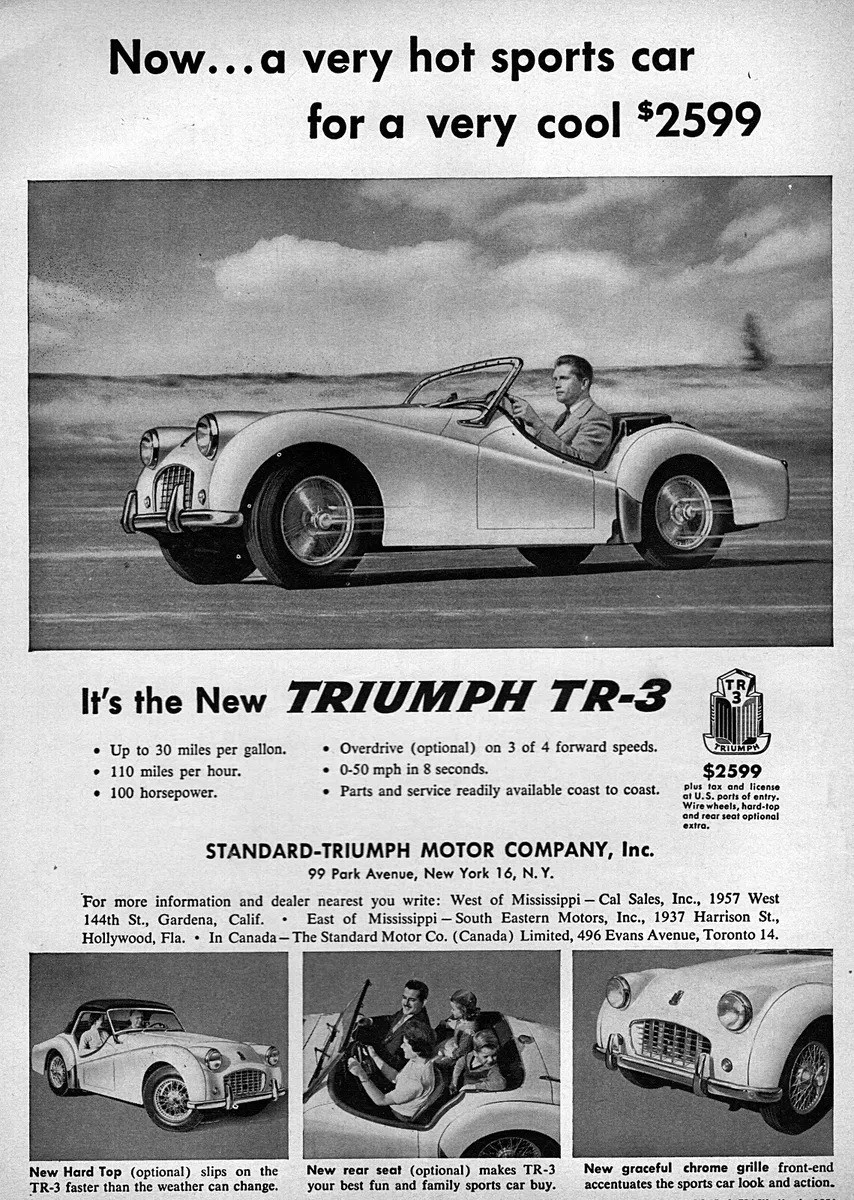The differences between a TR2 and a TR3
At the Earl’s Court Motor Show of 1952, Triumph showed the first iteration of the TR2. It was a popular attraction, and the company felt it would succeed very well in the United States. Once production commenced in August of 1953, most of them were sent to North America. Costing roughly $2,500, TR2 sold very well, with several of them being entered into Sports Car Club of America (SCCA) events. By the time production ceased in September of 1955, 8,636 had been built.
The TR3 took the baton from the TR2 with refreshed styling and brought with it several improvements over the TR2. Horsepower increased, thanks to larger SU carburetors; later, another bump would occur with the new “high-port head,” and revised manifold. The 4-speed manual transmission could be opted with an electrically-engaged overdrive, and by 1956, disc brakes would replace drums, a first for a British production car. Interestingly, despite certain handling idiosyncrasies, the basic chassis would soldier on from the TR2 through the TR4.
For 1957, the TR3A was introduced, although the nomenclature of the “A” is normally used only by enthusiasts. The “A” denoted revised styling and convenience features like exterior door handles and a lockable trunk, as well as bigger tires, which, with the new disc brakes, made the TR an exceptional handler for the day, despite certain characteristics. Roughly 58,000 were built by the time the TR3A ceased production and the TR3B was ushered in, again, the “B” never an official part of the model’s name.
What is the Triumph TR4?
The Triumph TR4 is the first major evolution of the original TR. Introduced in 1961, it was styled by Giovanni Michelotti and ushered the TR into a very modern realm of styling, with an almost perfectly flat beltline, a gently sloping hood with raised arches to accommodate the headlights, and more. It looked almost nothing like the outgoing TR and would span through 1976 with a multitude of changes.
What changes did the TR4 have?
The TR4 sustained use of the inline 4-cylinder engine seen in the earlier TRs, but increased displacement to 2138cc with either two Zenith-Stromberg or two SU carburetors, depending on who was selling carburetors to the factory. For customers wanting to race in the under 2-Liter class, Triumph continued to offer the original 1995cc 4-cylinder engine.
The chassis was almost unchanged; however, the TR4 benefited from rack-and-pinion steering, revised suspension geometry, larger front brake calipers, a live rear axle with semi-elliptical springs, and lever-arm dampers. The larger tires and wheels provided better grip and, along with the suspension revisions, improved the overall ride, something many owners had long complained about TR.
An exceptional step up from the original TR formula, the TR4 sold over 40,000 units in 5-years, and a batch of them were used by police departments in England as “Fast Pursuit Cars,” further building on their image of performance and durability.

What is the TR4A?
Introduced in 1965, the TR4A built on the chassis of the TR4 with an independent rear suspension, and wider front and rear wheel tracks. The idea was to improve both ride and handling, but many critics of the day declared the work to have improved the ride, but created unpredictable handling characteristics. A number of owners reverted their TR4As back to a live rear axle package, forgoing the supple ride in favor of better handling. Outside of some minor trim and design changes, the TR4 and TR4A are very, very similar.
What is the difference between the TR4A and the TR5?
Simply put, the TR5 brought a 2.5L inline 6-cylinder engine to the TR program, giving it a major boost in performance and panache – after all, everyone wants a 6-cylinder, right? It was good for 150 HP when it was equipped with the Lucas fuel injection system, or 106 HP with the twin carburetors. The North American market would receive the TR250, made only with the carburetors to meet US emissions and efficiency regulations, while Europe and the Rest of the World (ROW) cars would get the fuel injected engine.
Produced only from August of 1967 to September of 1968, the TR5/TR250 enjoyed only a short run, but showed the world what Triumph was up to in terms of providing performance for a wider audience of people through respectable prices. Case in point, the Porsche 911 of 1968 produced 158 HP, yet cost a bit more than double that of the TR5/TR250. The TR5/TR250 was available with a number of options like wire wheels, an overdrive transmission, a tonneau cover, a removable hardtop, and even air conditioning, all furthering the upscale image of the TR.
By the time production ended, Triumph had produced just over 8,000 TR250s, but less than 3,000 TR5s in the same time span.
Continuing reading more about the TR6 through TR8 models here. {part 3 of 3}